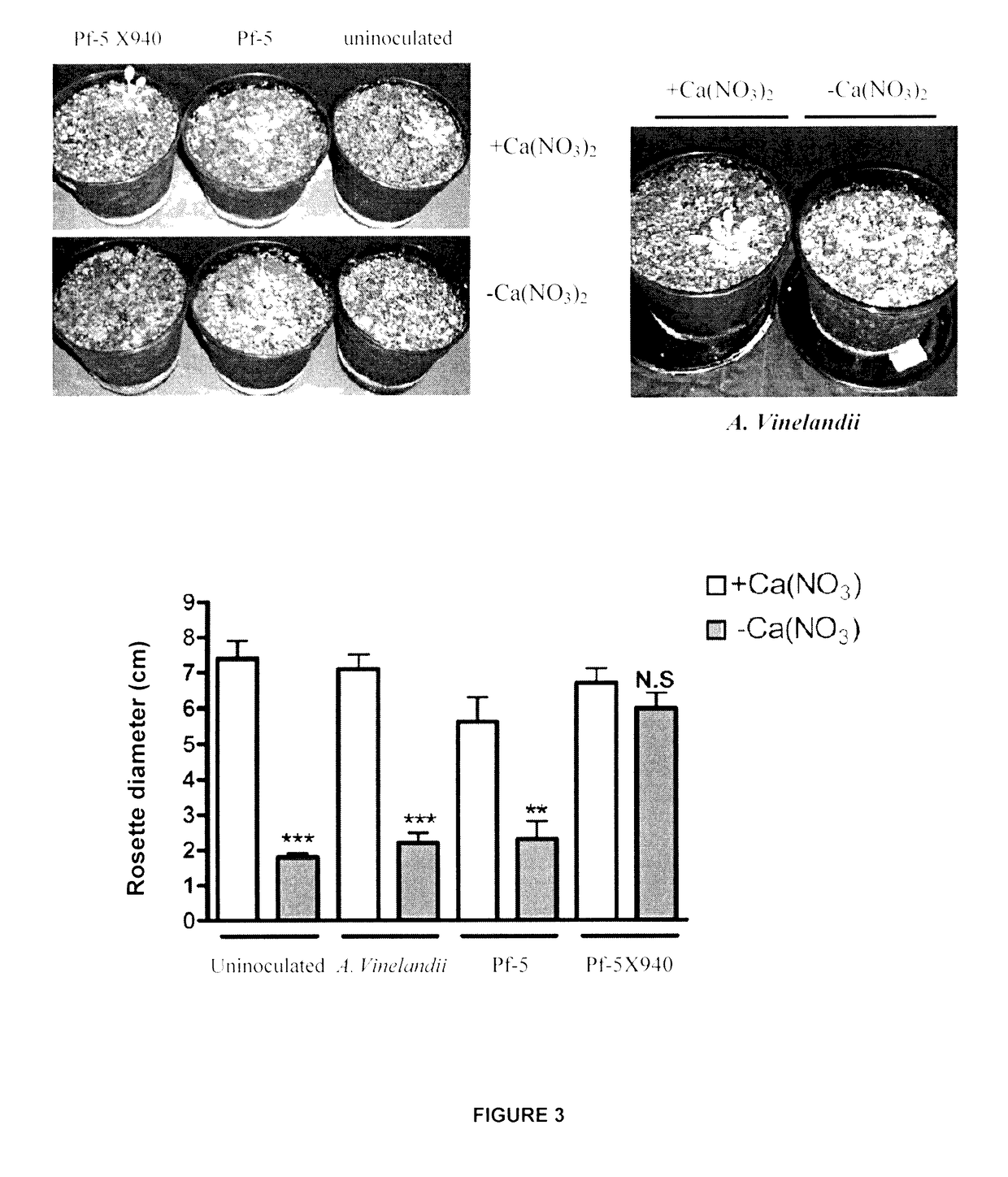Recombinant nitrogen-fixing bacterial strain, inoculum containing the same and application methods
a technology of nitrogen fixing bacteria and inoculum, which is applied in the direction of bacteria-based processes, biocide, peptides, etc., can solve the problems that strains are not employed to improve productivity, and achieve the effect of improving plant productivity
- Summary
- Abstract
- Description
- Claims
- Application Information
AI Technical Summary
Benefits of technology
Problems solved by technology
Method used
Image
Examples
example 1
ion of Recombinant Bacteria of the Invention
[0020]Two 255 bp segments of PST_1306-PST_1307 and PST_1312-PST_1313 intergenic regions of (CP000304) Pseudomonas stutzeri A1501 were obtained through PCR using the following primers:
[0021]
SEQ ID N° 1:5′-CGGGATCCCCGAATAGAGGTCTGTCCCCG 3′SEQ ID N° 2:5′-CGGGATCCCCGGGGCGCTGGTGC3′SEQ ID N° 3:5′-CGGTCGACTCGGTGCGGCGCTCG3′-SEQ ID N° 4:5′-CGGTCGACGCCAAGGCCGCCCGC 3′,
where the BamHI and SalI restriction sites have been underlined, respectively. The PCR cycle used for both amplification reactions was the following: 3 minutes at 94° C. (201.2° F.); 34 cycles of 45 seconds at 94° C. (201.2° F.)—30 seconds at 50° C. (122° F.)—30 seconds at 72° C. (161.6° F.) and 10 minutes at 72° C. (161.1° F.). The amplification segment corresponding to the PST_1306-PST_1307 intergenic region was digested with BamHI and bound to a kenamycin resistance gene obtained from the plasmid pUC4K (X06404) digested with BamHI, resulting in Plasmid A. The amplification segment cor...
example 2
Growth Conditions
[0023]The cultures were made in 125 ml Erlenmeyer flasks containing 25 ml of incubated L medium at 28° C. (82.4° F.) with stirring at 300 rpm. The L medium was prepared according to the following formula: 1 g KH2PO4, 3 g K2HPO4, 0.1 g NaCl, 0.5 g (NH4)2SO4, 0.25 g MgSO4 7H2O, 1 mg FeCl3 6H2O, 0.017 mg CuCl2 2H2O, 0.029 mg ZnSO4 7H2O, 0.144 mg MnCl2H2O, 0.147 mg CaCl2 2H2O, 0.005 mg NaMoO4, 1 g citric acid, 5 g glucose, 100 mg yeast extract, 1 L, pH=7. Two aeration conditions termed aerobiosis (Erlenmeyer flasks covered with Parafilm) and microaerobiosis (Erlenmeyer flasks covered with a screw lid) were used. In order to assess the growth in limiting nitrogen conditions, the L medium was used but without the addition of nitrogen, i.e. without the addition of (NH4)2SO4. The cultures started from an optical density of 0.05-580 nm. The pre-cultures used to make the cultures were performed under the same conditions as the culture (25 ml of L medium in 125 ml Erlenmeyer f...
example 3
on of the Inoculum
[0024]The cultures were made in 125 ml Erlenmeyer flasks containing 25 ml of incubated L medium at 28° C. (82.4° F.) with stirring at 300 rpm during a period of 24 hours from LB agar plates. The culture was centrifuged at 10,000 g during a period of 5 minutes and it was resuspended in 25 ml of physiological saline (FS: 9 g NaCl / l). Then, the amount of bacteria present in these resuspended cultures was assessed, which resulted in the following value range: 8.108-2.109 CFU / ml. Each pot of 1 liter volume was inoculated with 0.2 ml of resuspended culture.
PUM
| Property | Measurement | Unit |
|---|---|---|
| volume | aaaaa | aaaaa |
| volume | aaaaa | aaaaa |
| volume | aaaaa | aaaaa |
Abstract
Description
Claims
Application Information
 Login to View More
Login to View More - R&D
- Intellectual Property
- Life Sciences
- Materials
- Tech Scout
- Unparalleled Data Quality
- Higher Quality Content
- 60% Fewer Hallucinations
Browse by: Latest US Patents, China's latest patents, Technical Efficacy Thesaurus, Application Domain, Technology Topic, Popular Technical Reports.
© 2025 PatSnap. All rights reserved.Legal|Privacy policy|Modern Slavery Act Transparency Statement|Sitemap|About US| Contact US: help@patsnap.com



